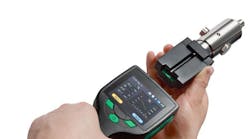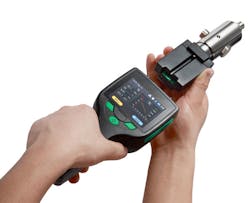This file type includes high resolution graphics and schematics when applicable.
The primary tests used to sample compressed air quality are gravimetric analysis and gas chromatographs. Gravimetric analysis deals with the mass concentration of anticipated contaminants, including general gas constituents, particulates, and moisture content. This could prove beneficial for testing plant, instrument, or breathing air. Gas chromatographs are used to find a specific gas constituent, such as nitrous oxide, hydrogen sulfide, or sulfur dioxide, in ppm by weight or volume or in µg/m3. (There are also particulate tests for inlet filter selection. These screen tests will report the percentage of total particulate by micron size.)
Hygrometers
Hygrometers help determine the atmospheric or pressure dew point of air. It is important to decide whether you need a pressure or atmospheric monitor. The pressure dew-point monitor is typically inserted directly into the system’s air flow, while the atmospheric monitor uses a sample tube and a cell, into which a sensor is inserted. Monitors can handle many different pressure dew-point ranges; –0° to –100°F, –40° to 40°F, 0° to 75°F, and –50° to 80°F are common.
Careful installation of hygrometers is critical, because most sensors contain activated alumina or lithium crystal, which cannot handle liquid slugging or exposure. (A few optical hygrometers can handle infrequent slugs of liquid, though.) Thus, damaging the sensor may be very costly. It does seem odd that something that measures the presence of moisture cannot handle moisture in a liquid state!
The air system should be dried before installing the sensor. This may mean several days of running time, to ensure total removal of liquid. (It should be determined whether the sensor is capable of transient or continuous high-relative-humidity conditions; if so, also determine the length of the recovery time.) Often times, a high dew-point alarm is available, and in many cases, 4- to 20-mA output for trending is an option.
When installing this type of equipment, the goal is to check the air quality going downstream to the users—not the performance of the treatment equipment. If an expander, intermediate control, or other metering device is being used, the test equipment should be installed at the final entry point to the overhead system downstream of this equipment.
Other Monitors
More sophisticated monitors have been developed to measure contaminants in compressed air, such as total carbon analyzers, particle counters, and nephelometers. (A nephelometer measures the concentration of suspended particulates in a fluid—liquid or gas—by using a light beam and a light detector.) These devices are delicate in nature and require careful selection and installation. Some are photometric, with a laser diode or other light source. Others rely on mirrors along with light.
These instruments will at times suffer from optical clouding, where the optics can be obscured by heavy contamination. Another problem is frequent calibration and cleaning, which typically occurs when a system cools down during depressurization. Sophisticated monitoring equipment might have to be disconnected from the system before shutdown, and then reconnected once the system is back online and the air quality has stabilized.
Another issue to check on is whether any limitations exist as to the phase of the contaminant being measured, such as vapor phase or liquid. Some of these devices cannot distinguish between different types of contaminant, so care should be taken in determining the constituents with a sample test before ordering or installing one of these complex and expensive online monitors.
Particular interest in one type of contaminant doesn’t change the fact that other non-specific contaminants may be present that could alter the quality or quantity of the collected information. Some recently developed photometric monitors can provide a wide range of sample monitoring, such as particulates, hydrocarbons, temperature, pressure, and dew point in the same sample instrument.
Many vendors offer carbon-monoxide (CO) monitors, which typically monitor only CO. These relatively delicate devices need frequent calibration via calibration canisters with CO in the gas stream at the alarm level. Some can also monitor for other non-specific aggressive gases. Though a bit more sensitive, these also provide added protection for the air user. Excessive moisture can negatively affect CO monitors because of the damage water can inflict on the load cells or sensors.
Compressor-Lubricant Detection
Micro-impingers are relatively simple, inexpensive monitoring devices. They use a litmus-like sampling tube that’s connected to the compressed air piping system. The device takes a small (1/32 cfm) sample of the air from the wall of the piping system and indicates the presence of most compressor lubricants or other condensed liquids with carbon material present. This is accomplished by changing the color of the material in the sample tube. The tubes have incremental indications that relate to ounces per 100,000 ft.3 of air tested.
Although the technique is relatively inaccurate, micro-impingers are able to indicate the presence of condensable hydrocarbons and other fluids containing carbon. Most compressor fluids and condensable gases present at the inlet of the compressor have some carbon in their base stock or additive packages.
These devices will also percolate liquid water from the top of the exhaust port if liquid water is present in the compressed air at the sample location. Installation of these devices (downstream of filters and dryers) serves as a good predictive indication of performance of upstream treatment equipment designed to remove the tested contaminant.
Micro-impingers require visual inspection on a regular basis. Manufacturers recommend that a 15-min. sample be taken on a daily or shift basis. Alternately, these devices can be left on continuously when installed downstream of treatment equipment that’s intended to remove the subject contaminants. Noting the presence of these contaminants can serve as an alert to predictive maintenance needs long before symptoms will be noticed.
In most industrial or process environments, micro-impingers serve as a good early-warning system. It is more important to know that a contaminant has worked its way downstream of treatment equipment at specific locations than it is to measure the quantity of contaminant once it enters production or processes.
Temperature and Pressure
Temperature and pressure are important to monitor in the system for a variety of purposes. The list below represents just part of the data that may deliver a more effective predictive maintenance program for better, more consistent air quality:
- Â Aftercooler discharge pressure and temperature
- Â Cold temperature differentials
- Â Inlet conditions for aftercoolers, which would indicate compressor maintenance needs
- Â Filter dirt loading and channeling overloading of dryers with mass flow or heat load
- Â Underloading of dryers with heat load
Some facilities often face the following situation: Maintenance personnel are assigned to take pressure and temperature readings at 40 to 50 monitoring points at least once per shift. (Collecting this data can consume several hours.) The fallacy with this exercise is that data is collected, but then just hung on the wall or stored for posterity. The individuals collecting it don’t understand its significance, and while someone else in maintenance or plant engineering may know how to diagnose the pressure and temperature information, they never see it.
What’s more, the accuracy of the pressure and temperature instruments used in many plants is of relatively poor quality and uncalibrated. An audit frequently reveals that these gauges are as much as ±7% off the metrology standard for testing purposes. Even if the information gathered was diagnosed by a knowledgeable individual—or if he or she had manufacturer’s data indicating benchmarked levels to watch for—the quality of the information would not provide dependable feedback.
It is the instrument manufacturer’s position that this is a consumer-driven market, and if the consumer doesn’t ask for dependable gauges, why would manufacturers supply them at extra cost when they would be unable to recover the cost? The OEM certainly has a point. On the other hand, they do not report the standard quality of the gauges that are applied to the equipment, nor the impact that this may have on diagnostic results. (This includes analog as well as digital instruments.)
Another problem frequently seen is that the minor divisions used on these gauges are so rough that maintenance personnel can barely use the information, despite its inaccuracy. One option is to specify high quality, instrument-grade gauges that can be calibrated, and with 1 psig or 1°F minor divisions on compressors, dryers, filters, and cooling equipment. However, because of the standard mark-ups by equipment manufacturers for non-standard options (and the delay in manufacturing to support these changes), a better alternative is to install instrument taps and tees. Therefore, sophisticated pressure and temperature-monitoring equipment can be used to collect individual and differential information.
In a relatively small system with four compressors, one or two dryers, and two to four filters, there are probably 22 to 26 data points for pressure and temperature. That would require between 44 and 52 quality pressure and temperature gauges. The cost for this instrumentation can easily top $5,000!
Installing instrument taps at all data points would allow for using one tap for both pressure and temperature, and with 1/3 to 2/3 of the money, investment in a few high-quality pressure and temperature instruments that can monitor air, water, and refrigerant. At the high end of the test-equipment range reside multichannel, handheld instruments that can accurately determine pressure and temperature differentials.
It may be wise to employ permanently installed pressure- and temperature-monitoring equipment with downloadable trending on treatment equipment inlet and outlet temperature and pressure. This could be used for top-of-the-line predictive maintenance by observing trends in collected data.
This information was excerpted from a multi-part series on improving compressed-air efficiency in the Fluid Power Handbook & Directory.
This file type includes high resolution graphics and schematics when applicable.





